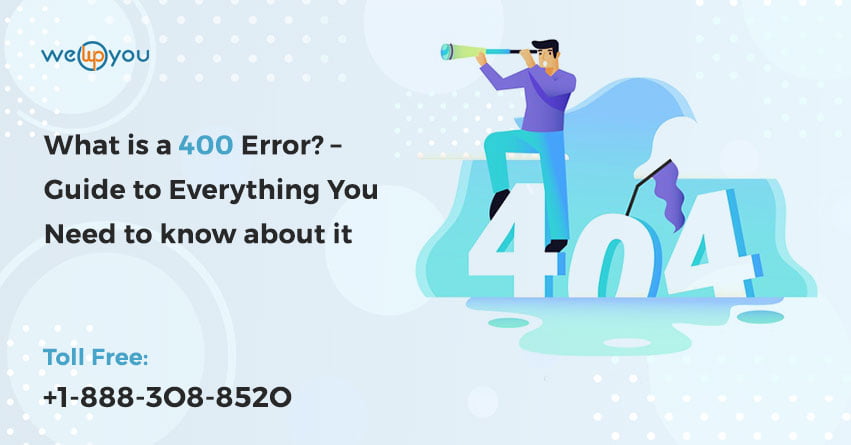When you run a WordPress website then it is very common to come across some kind of HTTP Error. Generally, these errors are temporary ones. You can get rid of them by using appropriate methods. HTTP Error 400 is one of such errors. At this point you must be wondering what is a 400 error. Here we have discussed everything about HTTPS response code 400.
What is HTTP Error 400?
Generally, this error takes place when a user tries to send a request to the server but the requests cannot get processed. There can be many reasons for this. In some cases, the browsers send such requests that cannot be processed by the webserver.
Now the main question comes, what can you do to get rid of this error. Here are a few steps that you can take in order to fix the HTTP Error 400.
Check the URL: There are chances that you have made a mistake while typing the URL of the requested page. This can also cause the HTTP Error. So always make sure that the URL you have entered is correct. For this, you have to check every small detail like the path, the title, and the query-string portions.
Clear the cookies and browser history: the next solution is to clear the cookies and browser history. In most of the cases, this gets rid of the HTTP Error 400 on your website.
Send the Request Again: If the above solutions do not work then you can try sending the request all over again. This way you make sure that there are no cache elements present anymore. And this will help you to get your website back up and running.
File upload size: There are chances that this error is occurring because of some issues in the backend script itself. This error can take place when you try to upload a media file that is too large in size or is not in the required file format. If you find out this reason then you should upload the media file again. And get rid of the media file that you have uploaded previously.
Get Rid of Malformed Headers: There are very few chances of this being the reason for the error. But there are still chances that malformed headers can cause this error on your website. In order to fix this issue, you have to get rid of those malformed headers.
Update Browser and Deactivate Plugins: This is one of the most common solutions that you can try to get rid of the HTTP Error 400. By updating the browser, the error generally disappears on its own. But if it does not that you can also try deactivating all the plugins. If the error is no longer there after doing so then you should understand that one of your plugins is causing this issue. To find out the faulty one, you have to enable them one-by-one. When the error comes back after reactivating a specific plugin, you have your answer. To find a permanent solution for the error, you have to delete that faulty plugin and find an alternative for that.
Check the Internet Speed: In some cases, this error can take place on your website if the internet connection you are using is not working properly. In such a scenario, it is recommended to check the internet connection and do what is required.
By now you must have realized what the HTTP Error 400 is all about.
All about 400 Errors –Other 4XX Errors:
This particular set of HTTP errors indicated that the request you have made has either bad syntax or cannot be processed for some other reason. Generally, this happens because of some mistakes of the client who is sending the request. We have discussed HTTP Error 400 Bad Request in great detail. Here, we are going to discuss other 4xx errors that can take place on your website.
HTTP Error 401 – Unauthorized:
This error takes place when the webserver requires a user authentication in order to process the request. This error can also occur when the server refuses the authorization provided by the client. When the HTTP error 401 takes place it means that either the username and or the password is incorrect. There are also chances that both of them are incorrect.
HTTP Error 402 – Payment Required:
Although this status response code is for future use. In some cases you come across this when the web server cannot process the request until the client makes the required payment.
HTTP Error 403 – Forbidden:
This error occurs when the server is stopping you from accessing the requested page. It could happen for any reason and there is not much you can do to fix this error.
HTTP Error 404 – File Not Found:
This error takes place when the web server cannot process the request made by you because it cannot find any files specified by the requested URL address. Although the server finds the request valid. The error message displayed on the screen does not give any indication if the error is temporary or permanent. Most of the people confuse the error ‘File not found’ with the error ‘server not found’. But both of them are different.
In some cases, it is possible that the request is redirected to a wrong server. This can happen because of the corrupted DNS entries.
HTTP Error 405 – Method Not Allowed:
When this error takes place it simply indicates that the method specified in the request is not allowed for the resource identified in the request URL. It can happen for many reasons. The one common reason is, when the web server is not configured to accept requests from visitors at all. You can find all the 405 errors in the server logs. So if you are not able to understand that error, you can always take help by checking the logs.
HTTP Error 406 – Not Acceptable:
Whenever the client makes a request, there is an option to indicate the kind of data it will accept back. So that the web server can return the data accordingly. But when the web server finds out that the kind of response it can return is not acceptable by the client then the HTTP Error 406 takes place. This error occurs very rarely.
HTTP Error 407 – Proxy Authentication Required:
This HTTP error takes place when the request made by the client was valid but the client will have to authenticate itself with the proxy first. Only after that it will be able to access the URL. When this happens, you should log in with the proxy server first.
HTTP Error 408 – Request Timeout:
This HTTP error takes place when the client cannot make the request within the specific time window. Every web server has a configuration that it waits for a particular time for a request. If you do not make the request within that time then it will lead you to an error. In such a scenario, you will have to repeat the request after some time. You can repeat the request and there is no need to make any changes. When this error is persistent on your website then it could happen because of the extra workload on the web server or a connectivity problem.
HTTP Error 409 – Conflict:
You will come across this error on your website when the web server cannot process your request due to a conflict with the current state of the resource. Although your request is being considered valid. Generally, the error message gives plenty of information about the error. This makes it easy for you to find out the problem causing factor and fix it.
HTTP Error 410 – Gone:
You will receive this HTTP error when the resource for which the client has made a request is no longer available at the server. And this will not be available again. In this case, there is no address on which it can be forwarded to. This is one of the few HTTP errors that are permanent.
HTTP Error 411 – Length Required:
This error takes place when the webserver refuses to accept the request that does not have a preset content-length. In order to get the request processed the client will have to add a valid content-length header field before repeating the request.
HTTP Error 412 – Precondition Failed:
In a website, there is a precondition given in the requests-header fields. It can be in one or more. If these fields come out as false when they are tested on the server then you will come across the HTTP Error 412.
HTTP Error 413 – Request Entity Too Large:
This error takes place when the web server does not process a request because the request entity is too large. It should never be larger than what the server is able to process. In such a scenario, there are chances that the webserver will break the connection. This does so to stop the client from repeating the request.
HTTP Error 414 – Request-URL Too Long:
You will come across this error on your website when the webserver refuses to process the request because the Request-URL is too long. In any case, the request-URL should not exceed the length that the server is able to interpret. This happens very rarely.
HTTP Error 415 – Unsupported Media Type:
This HTTP error takes place when the server refuses to process the request it contains an entity in an unsupported file format.
HTTP Error 417 – Expectation Failed:
You will receive this HTTP error when there is an expectation given in an Expect request-header field; but it could not be fulfilled by the webserver. Or the other case is when the server is a proxy and has clear reasons that the request cannot be completed by the next server.
HTTP Error 421 – Misdirected Request:
This error takes place when the request made by the client was directed to a server that cannot provide a proper response.
HTTP Error 422 – Unprocessable Entity:
This HTTP error occurs when the request made by the client is valid but has some semantic errors. And this is why this cannot be processed.
HTTP Error 423 – Locked:
This error takes place when the resource that is being accessed is locked.
HTTP Error 424 – Failed Dependency:
This error takes place when the request made by the client cannot be processed because it has failed dependency on another request.
HTTP Error 425 – Too Early:
This status code means that the web server cannot process the request made by the client that has chances of being replayed. It increases the chances of replay attacks.
HTTP Error 426 – Upgrade Required:
This error takes place when the webserver cannot process the request using the current protocol. But it can be processed once the client will upgrade to a different protocol.
HTTP Error 428 – Precondition Required:
This status code indicated that the origin server web server needs the request to be conditional so that it can be processed.
HTTP Error 429 – Too Many Requests:
This HTTP error takes place when the user tries to make too many requests within a given window of time. In such a scenario, the webserver cannot process all the requests made by the client.
HTTP Error 431 – Request Header Fields Too Large:
This error takes place when the webserver cannot process a request made by the client because it has HTTP headers that are too large. You can try repeating the request but before that make sure that you reduce the size of the request header.
HTTP Error 451 – Unavailable For Legal Reasons:
This HTTP error takes place when the client has requested a resource that is not available. This becomes unavailable because of some legalities. You cannot do anything to get rid of this error.
Wrapping Up!
If you have been running a website for quite some time now then by now you must have realized that it is very common to run into HTTP errors. Generally, these errors are temporary. Some of them might seem very difficult to fix at first but when you follow the right process, you can easily get rid of that. If you are someone who is wondering what is a 400 error then you have come to the right place. In the above blog, we have explained this error. Additionally, we have also explained other 4XX errors so that you can get a better understanding of things.
If your mind is now full of queries related to any of the errors mentioned above then this is the case when the need for some expert help arises. At this point, you must have started wondering from where you can get the right help. There is no need to worry. You can contact us for all of your queries. Our team of WordPress Support experts will assist you in every possible way. You can give us a call on 1-866-332-O276. We work 24×7.
FAQs:
Can we fix the 400 bad request by refreshing the page?
In some cases, it can fix the issue.
Is it possible that a mistake in typing the URL causes an error?
Yes, it is possible.
Are the two errors ‘file not found’ and server not found’ same?
No, both of them are different.
Does HTTP Error 414 take place very commonly?
No, it is one of the rarest errors.
Can we do anything to fix the HTTP Error 403?
No, there is not much that you can do to fix this error.




